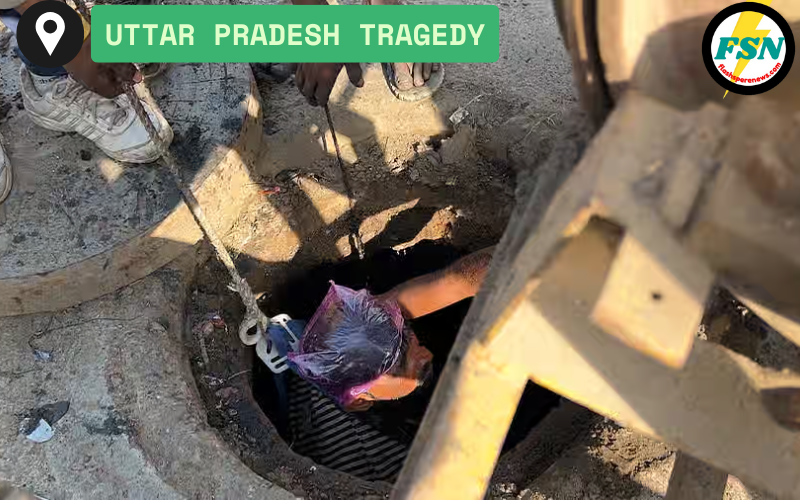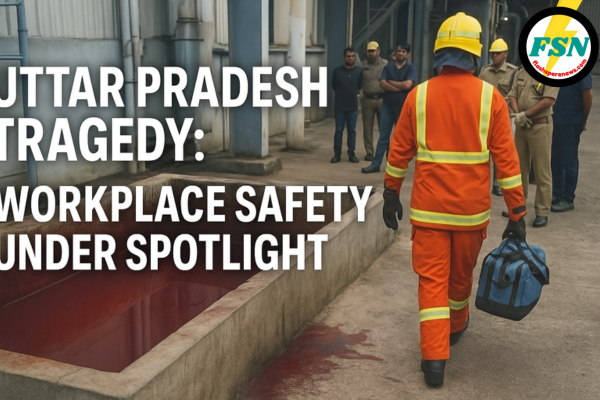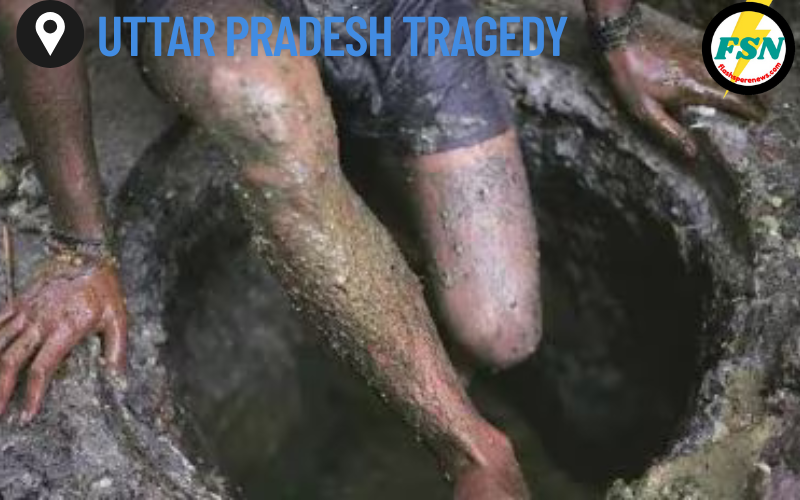Shocking Uttar Pradesh Tragedy : Two Workers Drown in 12-Foot-Deep Blood Collection Tank
Introduction
In a horrifying incident that has left the community of Aligarh, Uttar Pradesh, in shock, two workers lost their lives after drowning in a 12-foot-deep blood collection tank. The tragic event has raised questions about industrial safety protocols and the wellbeing of workers in such environments. This Uttar Pradesh tragedy has become a grim reminder of the dangers lurking in industries that often go unnoticed. Authorities are now under pressure to investigate the incident thoroughly and ensure such mishaps do not occur in the future.
The incident has also sparked concerns over the growing disregard for safety in industries operating in Uttar Pradesh. Families of the victims are calling for stricter enforcement of safety regulations, while the public at large demands accountability from both private companies and government authorities.
A Routine Task Turns Fatal
The incident occurred in an industrial area of Aligarh, where a blood collection tank, used in the meat processing industry, became the site of a fatal accident. According to local reports, the two workers were performing routine maintenance tasks when they slipped into the tank. The depth of the tank and its contents made it impossible for the workers to escape, turning a routine task into a devastating Uttar Pradesh tragedy.
Witnesses at the scene described a chaotic and heart-wrenching scenario as efforts to rescue the workers proved futile. Emergency services were called immediately, but by the time they arrived, it was too late. This grim incident highlights the urgent need for better safety measures in industrial settings, especially in high-risk environments.
The workers involved in the tragedy were reportedly not equipped with adequate protective gear, which could have prevented this disaster. The absence of safety railings around the tank and the lack of emergency equipment further exacerbated the situation. It is essential to delve deeper into the systemic issues that allowed such negligence to occur.
Industrial Safety Under Scrutiny Uttar Pradesh tragedy
This Uttar Pradesh tragedy has brought the spotlight back on industrial safety standards in the state. The factory where the incident occurred is now under investigation. Preliminary findings suggest that the facility lacked adequate safety protocols, such as protective gear for workers and emergency response mechanisms.
Experts have emphasized that accidents like these are preventable with the right precautions. For instance, safety harnesses, regular training sessions, and proper supervision could have averted this disaster. This raises a critical question: Are companies prioritizing profits over worker safety? The Uttar Pradesh tragedy serves as a wake-up call for industries across the region to reevaluate their safety policies.
The need for stringent laws and regulations to prevent such incidents cannot be overstated. Legislators and industry leaders must collaborate to establish standards that prioritize worker safety. Moreover, regular audits and inspections should be conducted to ensure compliance with these standards.
Additionally, industry watchdogs and labor rights organizations are calling for greater transparency in reporting safety violations. These measures will not only enhance accountability but also empower workers to voice concerns without fear of retaliation. This tragedy underscores the necessity for a cultural shift towards prioritizing safety in the workplace.
Community Reactions to the Uttar Pradesh Tragedy
The incident has left the local community in shock and grief. Families of the deceased workers are devastated, grappling with an unimaginable loss. Local leaders have also expressed their condolences and called for swift action against those responsible for this negligence.
Residents in the area have started voicing their concerns about the lack of oversight in industrial operations. Many feel that authorities need to take stronger measures to ensure worker safety, especially in hazardous industries. This outpouring of grief and anger underlines the emotional and societal impact of this Uttar Pradesh tragedy.
Local community groups and activists have come forward to support the families of the deceased. From organizing fundraisers to providing legal assistance, these efforts reflect the solidarity and resilience of the community. The incident has also sparked discussions about the importance of community vigilance in holding industries accountable.
Some residents have shared their personal experiences of working in similar industries, highlighting the pervasive culture of neglect and exploitation. These firsthand accounts add a human dimension to the tragedy, emphasizing the urgent need for systemic reforms.
Government’s Response of Uttar Pradesh tragedy
In the wake of the incident, the Uttar Pradesh government has announced a detailed investigation. Officials have promised stringent action against those found guilty of negligence. Additionally, labor departments have been instructed to conduct safety audits in similar facilities across the state.
Chief Minister Yogi Adityanath has expressed deep sorrow over the tragedy and assured the public that justice will be served. Compensation packages for the families of the deceased workers have also been announced, though critics argue that monetary relief is insufficient to address the root causes of such incidents.
Beyond monetary compensation, the government’s focus must shift to long-term solutions. Policies aimed at worker protection and industrial safety should be prioritized. Transparency in the investigation process will be crucial in rebuilding public trust and ensuring that justice is served.
The government has also sought assistance from industrial safety experts to review existing regulations and identify gaps. By involving external advisors, officials aim to bring fresh perspectives to the issue and implement best practices from other regions and countries.
The Larger Issue of Worker Safety in Uttar Pradesh

The Uttar Pradesh tragedy is not an isolated incident. Worker safety has been a longstanding issue in many industries, particularly in states with burgeoning industrial sectors like Uttar Pradesh. According to labor rights activists, inadequate safety measures and poor working conditions are common in many factories, leaving workers vulnerable to accidents.
This Uttar Pradesh tragedy has sparked a broader debate about labor rights and safety regulations. Advocacy groups are now demanding comprehensive reforms, including stricter enforcement of safety standards and regular inspections. The ultimate goal is to create a safer environment for workers and prevent another Uttar Pradesh tragedy.
The role of labor unions in advocating for worker rights cannot be understated. By empowering workers to voice their concerns and demand better working conditions, labor unions can play a pivotal role in preventing such incidents. Collaboration between unions, government bodies, and industry leaders will be key to driving meaningful change.
International comparisons can also provide valuable insights. Countries with robust worker safety laws, such as Germany and Sweden, have significantly lower rates of workplace accidents. By adopting similar measures, Uttar Pradesh can enhance its industrial safety framework and protect its workforce.
The tragedy also sheds light on the increasing pressure faced by workers in high-risk industries. Long working hours, inadequate training, and a lack of proper oversight create a dangerous environment that can lead to catastrophic outcomes. Addressing these underlying issues is essential to ensuring the safety and wellbeing of workers.
Lessons from the Uttar Pradesh tragedy
As investigations continue, this incident serves as a stark reminder of the importance of prioritizing human lives over operational efficiency. Industries must take proactive steps to ensure the safety of their workers. This includes investing in modern safety equipment, conducting regular training sessions, and fostering a culture of safety.
The Uttar Pradesh tragedy has also highlighted the role of government oversight. Regulatory bodies must remain vigilant and ensure compliance with safety norms. Public awareness campaigns can also play a vital role in educating workers about their rights and the importance of adhering to safety guidelines.
Case studies from other regions where industrial safety standards have significantly improved can offer valuable insights. Learning from these examples can help Uttar Pradesh implement effective strategies to enhance worker safety.
Experts recommend adopting a multi-stakeholder approach to address worker safety comprehensively. This involves collaboration among government agencies, industry associations, labor unions, and non-governmental organizations. By pooling resources and expertise, stakeholders can create a safer and more equitable industrial environment.
A Call to Action
While the Uttar Pradesh tragedy is a grim event, it also presents an opportunity for change. The incident has brought attention to the pressing need for better safety standards and stronger labor protections. Stakeholders—including industries, government bodies, and civil society—must work together to prevent such tragedies in the future.
Ultimately, the goal is to ensure that every worker can perform their duties in a safe and secure environment. By addressing the systemic issues that led to this Uttar Pradesh tragedy, we can honor the memory of those who lost their lives and pave the way for a safer future.
The journey towards safer workplaces requires collective effort. Awareness campaigns, stricter laws, and robust enforcement mechanisms are the need of the hour. Together, we can ensure that such tragedies become a thing of the past, and every worker returns home safely at the end of the day.
Educational institutions and training centers also have a role to play in enhancing worker safety. By incorporating safety education into vocational training programs, workers can be better prepared to handle risks and protect themselves in hazardous environments.
The importance of industrial safety cannot be overstated. Incorporating best practices from global standards and learning from such tragedies can create a blueprint for safer working conditions. Industries, governments, and communities must work in unison to achieve this goal.
Conclusion
The Uttar Pradesh tragedy serves as a grim reminder of the vulnerabilities faced by workers in hazardous industries. It is a call to action for all stakeholders to prioritize safety and accountability. By learning from this incident and taking proactive steps, we can prevent such disasters and create a safer future for all workers. Let this tragedy be the catalyst for meaningful change.
Moving forward, it is imperative that lessons from this incident are not forgotten. By committing to systemic reforms and fostering a culture of safety, we can ensure that every worker’s life is valued and protected. Together, let us work towards a future where tragedies like this are a thing of the past.
To ensure lasting impact, industries must adopt stricter safety standards, empower workers with the knowledge and tools to protect themselves, and foster a culture where safety is non-negotiable. By addressing the root causes of the Uttar Pradesh tragedy, we can build a future where worker safety is a cornerstone of industrial success.


